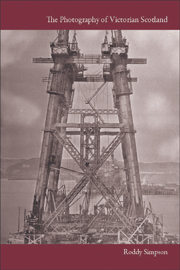Book contents
- Frontmatter
- Contents
- List of Figures
- Introduction
- 1 The Origins of Scottish Photography: Pioneering Activities in St Andrews and Edinburgh
- 2 David Octavius Hill and Robert Adamson: the ‘Partnership of Genius’ and the First Art Photography
- 3 Photography for the Few: The Activities of the Enthusiastic and Artistic Amateurs
- 4 Photography in Demand: The Work of the Increasing Number of Professional Photographers to Meet Public Demand
- 5 Scots Abroad: The Achievements of Scottish Photographers Around the World
- 6 Tourists and Travellers: Images of Scotland Produced for the Rapidly Growing Tourist Market and Photographs Taken by Visitors
- 7 Recording Social Conditions and Industrial Change: Photographs of what was Being Lost and what was Replacing it
- 8 Photography as Art: Looking at the Images and the Arguments
- 9 Populist Activity and Pictorialism: Popular Involvement with Cheap and Mass Produced Cameras and Photographers with Artistic Aspirations
- 10 Scotland's Enduring Photographic Legacy
- Bibliography
- Acknowledgements
- Index
7 - Recording Social Conditions and Industrial Change: Photographs of what was Being Lost and what was Replacing it
Published online by Cambridge University Press: 05 August 2013
- Frontmatter
- Contents
- List of Figures
- Introduction
- 1 The Origins of Scottish Photography: Pioneering Activities in St Andrews and Edinburgh
- 2 David Octavius Hill and Robert Adamson: the ‘Partnership of Genius’ and the First Art Photography
- 3 Photography for the Few: The Activities of the Enthusiastic and Artistic Amateurs
- 4 Photography in Demand: The Work of the Increasing Number of Professional Photographers to Meet Public Demand
- 5 Scots Abroad: The Achievements of Scottish Photographers Around the World
- 6 Tourists and Travellers: Images of Scotland Produced for the Rapidly Growing Tourist Market and Photographs Taken by Visitors
- 7 Recording Social Conditions and Industrial Change: Photographs of what was Being Lost and what was Replacing it
- 8 Photography as Art: Looking at the Images and the Arguments
- 9 Populist Activity and Pictorialism: Popular Involvement with Cheap and Mass Produced Cameras and Photographers with Artistic Aspirations
- 10 Scotland's Enduring Photographic Legacy
- Bibliography
- Acknowledgements
- Index
Summary
The decades that followed the announcement of the invention of photography were of unprecedented change socially and industrially, which especially affected towns and cities. Yet it was to take time before these changes became a subject for photography. The photographs made by the commercial photographers for tourists were essentially a romanticised view of Scotland, inspired by history and literature and especially the writing of Sir Walter Scott. This approach to creating images, along with portraiture, tended to be the pattern of early photography. Although much was written about social conditions, particularly the poor, the camera was slow to record these conditions. There seemed to be an even greater reluctance to record images of the poor themselves. There was an equal slowness to look at industrial activities. Photography may have been slow but it was ahead of the other graphic arts and when it did respond it excelled and created an art worthy of the great industrial achievements of the age. As well as the quality of the images produced, the documentary value of these photographs is immense, coupled with the visual excitement they transmit of ‘the drama, the complexity and the scale of the heroic age of steel and steam’.
The fact that photography was slow to look at engineering works in particular is perhaps surprising because as early as May 1840 a young Scottish Engineer, Alexander Gordon, presented a paper to the Institution of Civil Engineers on the benefits of photography to engineering by ‘enabling copies of drawings, or views of buildings, works, or even machinery when not in motion, to be taken with perfect accuracy in a very short space of time with comparatively small expense’.
- Type
- Chapter
- Information
- The Photography of Victorian Scotland , pp. 134 - 153Publisher: Edinburgh University PressPrint publication year: 2012

